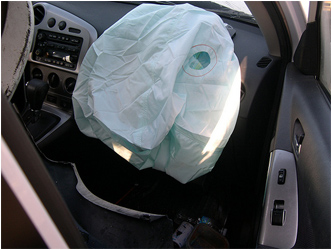The impulse – momentum theorem allows scientists to calculate changes in the momentum of objects and systems given known values of force and time. It also helps with engineering because it represents a trade-off between two physical quantities. In order to provide a large change in momentum, you either need a large force or a large time. An easy way to remember this concept is as follows:
Think of the brakes on your car as you drive—if you hit the brakes hard, you have a shorter stopping time. If you press them lightly, you have a longer stopping time.
![]() In the following picture of the brakes of a car, click to move the tab back and forth to see the trade-off between force and time interval.
In the following picture of the brakes of a car, click to move the tab back and forth to see the trade-off between force and time interval.
Engineers develop safety equipment with this idea in mind. If we can make the change in momentum take longer to happen, then less force will be required, and therefore less damage will be done.
Pole-vaulters land on a mat that compresses during the impact. This makes it take longer for the person to stop and therefore requires less force.

Source: Latvian, Flickr
Similarly, bumpers crumple zones, and air bags in cars could really be considered “crash extenders” because their primary purpose is to extend the amount of time of a crash so that the average force will be smaller.

Source: Air Bag, Prattman, Flickr